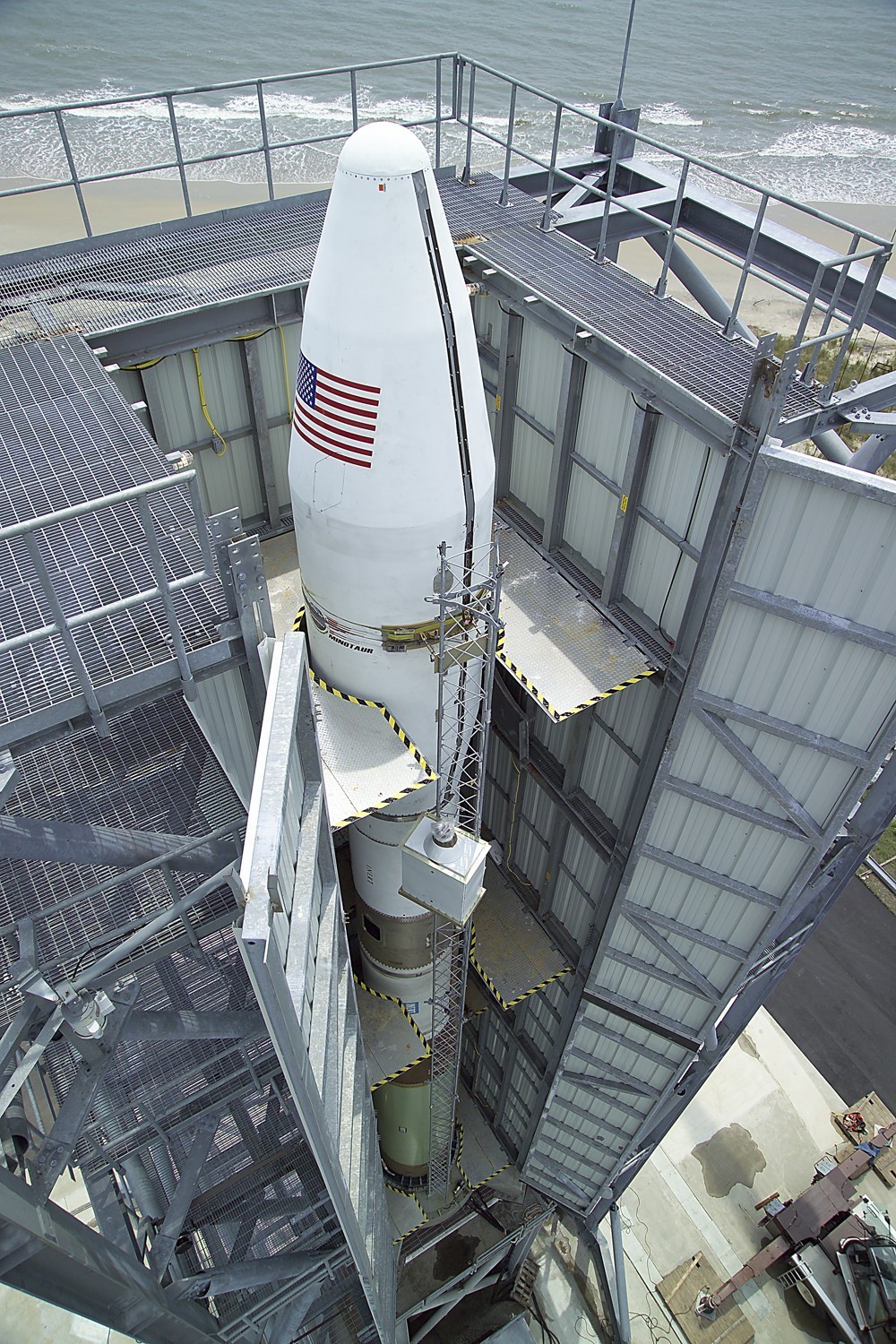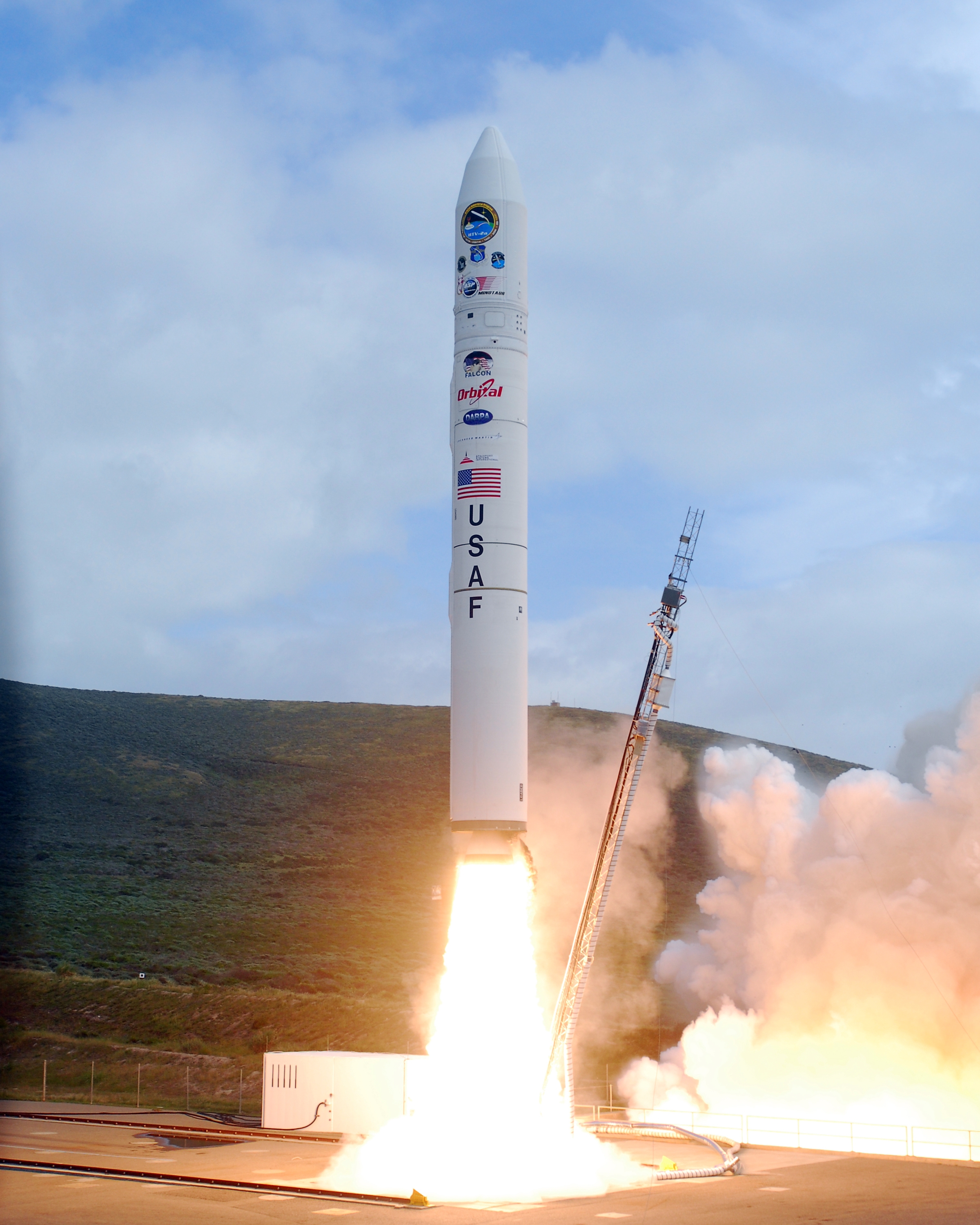Minotaur (rocket family) on:
[Wikipedia]
[Google]
[Amazon]


 The Minotaur is a family of United States
The Minotaur is a family of United States
"Taurus rocket on the market with new name, upgrades"
Spaceflight Now 24 February 2014 Minotaur-C (for "Minotaur-Commercial"), was the first of the Minotaur vehicle family, and the first ground-launched orbital booster developed by
Minotaur I Rocket page
Minotaur IV Rocket page
*
{{US launch systems Northrop Grumman space launch vehicles Orbital Sciences Corporation space launch vehicles Expendable space launch systems


 The Minotaur is a family of United States
The Minotaur is a family of United States solid fuel
Solid fuel refers to various forms of solid material that can be burnt to release energy, providing heat and light through the process of combustion. Solid fuels can be contrasted with liquid fuels and gaseous fuels. Common examples of solid fuel ...
launch vehicle
A launch vehicle or carrier rocket is a rocket designed to carry a payload ( spacecraft or satellites) from the Earth's surface to outer space. Most launch vehicles operate from a launch pads, supported by a launch control center and sys ...
s derived from converted Minuteman and Peacekeeper intercontinental ballistic missile
An intercontinental ballistic missile (ICBM) is a ballistic missile with a range greater than , primarily designed for nuclear weapons delivery (delivering one or more thermonuclear warheads). Conventional, chemical, and biological weapo ...
s (ICBM). They are built by Northrop Grumman
Northrop Grumman Corporation is an American multinational aerospace and defense technology company. With 90,000 employees and an annual revenue in excess of $30 billion, it is one of the world's largest weapons manufacturers and military tech ...
via contract with the Air Force Space and Missile Systems Center's Space Development and Test Directorate (SMC/SD) as part of the Air Force's Rocket Systems Launch Program which converts retired Intercontinental Ballistic Missiles into space and test launch systems for U.S. government agencies.
Three variants of the Minotaur are currently in service. The Minotaur I
The Minotaur I, or just Minotaur is an American expendable launch system derived from the Minuteman II missile. It is used to launch small satellites for the US Government, and is a member of the Minotaur family of rockets produced by Orbital ...
is an orbit
In celestial mechanics, an orbit is the curved trajectory of an object such as the trajectory of a planet around a star, or of a natural satellite around a planet, or of an artificial satellite around an object or position in space such as ...
al launch system used to launch small satellite
A satellite or artificial satellite is an object intentionally placed into orbit in outer space. Except for passive satellites, most satellites have an electricity generation system for equipment on board, such as solar panels or radioiso ...
s into low Earth orbit
A low Earth orbit (LEO) is an orbit around Earth with a period of 128 minutes or less (making at least 11.25 orbits per day) and an eccentricity less than 0.25. Most of the artificial objects in outer space are in LEO, with an altitude never m ...
(LEO). The Minotaur II is a target launch vehicle (TLV), also known as Chimera, used for suborbital flights, often as a target for tracking and anti-ballistic missile
An anti-ballistic missile (ABM) is a surface-to-air missile designed to counter ballistic missiles (missile defense). Ballistic missiles are used to deliver nuclear, chemical, biological, or conventional warheads in a ballistic flight trajec ...
tests. The Minotaur IV
Minotaur IV, also known as Peacekeeper SLV and OSP-2 PK is an active expendable launch system derived from the LGM-118 Peacekeeper ICBM. It is operated by Northrop Grumman Innovation Systems, and made its maiden flight on 22 April 2010, carrying ...
is a more capable LEO launch system. The Minotaur V
The Minotaur V is an American expendable launch system derived from the Minotaur IV, itself a derivative of the LGM-118 Peacekeeper ICBM. It was developed by Orbital Sciences Corporation, (now absorbed into Northrop Grumman Innovation Systems) an ...
is designed to reach higher orbits, including geostationary transfer orbit
A geosynchronous transfer orbit or geostationary transfer orbit (GTO) is a type of geocentric orbit. Satellites that are destined for geosynchronous (GSO) or geostationary orbit (GEO) are (almost) always put into a GTO as an intermediate step ...
(GTO) and trans-lunar trajectories. The Minotaur III is a version under development, which will be used for suborbital flights.
The Minotaur I and II are derived from the Minuteman missile, while the Minotaur III, IV and V are derived from the Peacekeeper.
Vehicles
Minotaur-C (Taurus)
The Taurus launch vehicle, later renamed Stephen Clark"Taurus rocket on the market with new name, upgrades"
Spaceflight Now 24 February 2014 Minotaur-C (for "Minotaur-Commercial"), was the first of the Minotaur vehicle family, and the first ground-launched orbital booster developed by
Orbital Sciences Corporation
Orbital Sciences Corporation (commonly referred to as Orbital) was an American company specializing in the design, manufacture, and launch of small- and medium- class space and launch vehicle systems for commercial, military and other governmen ...
(OSC), derived by adding a solid booster stage to the air-launched Pegasus
Pegasus ( grc-gre, Πήγασος, Pḗgasos; la, Pegasus, Pegasos) is one of the best known creatures in Greek mythology. He is a winged divine stallion usually depicted as pure white in color. He was sired by Poseidon, in his role as hor ...
rocket. The first flight, sponsored by DARPA
The Defense Advanced Research Projects Agency (DARPA) is a research and development agency of the United States Department of Defense responsible for the development of emerging technologies for use by the military.
Originally known as the A ...
, was in 1994. After a series of failures between 2001 and 2011, the launch vehicle was rebranded as Minotaur-C in 2014. Due to laws against selling government equipment, the Minotaur-C is the only available Minotaur launch vehicle for commercial launches.
Minotaur I
The original Minotaur launch vehicle, consisting of an M55A1 first stage, SR19 second stage, Orion 50XL third stage,Orion 38
Orion is a series of American solid-fuel rocket stages, developed and manufactured by a joint venture between Hercules Aerospace and Alliant Techsystems (now Northrop Grumman Innovation Systems). They were originally developed for use as all ...
fourth stage, and optional HAPS fifth stage for velocity trim and multiple payload deployment. Payload 580 kg to a 185 km, 28.5° orbit from Cape Canaveral
, image = cape canaveral.jpg
, image_size = 300
, caption = View of Cape Canaveral from space in 1991
, map = Florida#USA
, map_width = 300
, type = Cape
, map_caption = Location in Florida
, location ...
; or 310 kg to a 740 km Sun-synchronous orbit
A Sun-synchronous orbit (SSO), also called a heliosynchronous orbit, is a nearly polar orbit around a planet, in which the satellite passes over any given point of the planet's surface at the same local mean solar time. More technically, it is ...
(SSO) from Vandenberg.
Minotaur II
A suborbital target vehicle, essentially consisting of a Minuteman II with Orbital guidance and control systems. Consists of M55A1 first stage, SR19 second stage, and M57 third stage. Payload 460 kg on 6700 km suborbital trajectory.Minotaur III
A suborbital target vehicle, consisting of an SR118 first stage, SR119 second stage, SR120 third stage, and Super HAPS fourth stage. Payload 3060 kg on a 6700 km suborbital trajectory.Minotaur IV
The Minotaur IV combines U.S. government-furnished solid rocket motors from decommissioned Peacekeeper ICBMs with technologies from other Orbital-built launch vehicles, including the Minotaur I,Pegasus
Pegasus ( grc-gre, Πήγασος, Pḗgasos; la, Pegasus, Pegasos) is one of the best known creatures in Greek mythology. He is a winged divine stallion usually depicted as pure white in color. He was sired by Poseidon, in his role as hor ...
, and Taurus. The Minotaur IV launch vehicle consists of an SR118 first stage, SR119 second stage, SR120 third stage, and Orion 38 fourth stage. Payload 1735 kg to a 185 km, 28.5° orbit from Cape Canaveral. The first Minotaur IV was launched 22 April 2010 from Vandenberg Air Force Base in California
California is a state in the Western United States, located along the Pacific Coast. With nearly 39.2million residents across a total area of approximately , it is the most populous U.S. state and the 3rd largest by area. It is also the m ...
. This vehicle is also being developed to accommodate the Conventional Prompt Global Strike (CPGS) mission for the Air Force.
Minotaur V
The Minotaur V is a five-stage version based on the Minotaur IV+. It has an additional upper stage for small geostationary transfer orbit (GTO), lunar, and interplanetary missions.NASA
The National Aeronautics and Space Administration (NASA ) is an independent agency of the US federal government responsible for the civil space program, aeronautics research, and space research.
NASA was established in 1958, succeedin ...
's Lunar Atmosphere and Dust Environment Explorer (LADEE) mission was launched on the first Minotaur V, from the Wallops Island, Virginia
Virginia, officially the Commonwealth of Virginia, is a state in the Mid-Atlantic and Southeastern regions of the United States, between the Atlantic Coast and the Appalachian Mountains. The geography and climate of the Commonwealth are ...
launch site at 03:27 UTC on 7 September 2013. The Minotaur launched the LADEE spacecraft into a highly elliptic orbit where it can phase and time its trajectory burn to the moon.
Minotaur VI
A Minotaur VI five-stage version has also been conceptualized. It is also based on the Minotaur IV+, adding a second SR-118 first stage.Launch statistics
Rocket configurations
Launch sites
Launch outcomes
Launch history
Planned launches
See also
*Dnepr Dnepr may refer to:
*Dnieper, a river flowing through Russia, Belarus and Ukraine to the Black Sea
*Dnepr (motorcycle), a Ukraininan motocycle brand
*Dnepr (rocket), a 1999 space launch vehicle
*Dnepr radar, Soviet space surveillance and early warn ...
, a converted Soviet ICBM often used for commercial satellite launches
* Minotaur-C
Minotaur-C (''Minotaur Commercial''), formerly known as Taurus or Taurus XL, is a four stage solid fueled launch vehicle built in the United States by Orbital Sciences (now Northrop Grumman) and launched from SLC-576E at California's Vande ...
, the vehicle formerly known as ''Taurus''
* Modified Minotaur IV, Ascent Abort-2 (AA-2), was a suborbital flight to test the Launch Abort System (LAS) of NASA's Orion spacecraft. The suborbital flight used a modified Minotaur IV, launched July 2, 2019, at 11:00 UTC from CCAFS SLC-46. The suborbital flight was a success. Reference: Wikipedia article "Ascent Abort-2.
References
External links
Minotaur I Rocket page
Minotaur IV Rocket page
*
{{US launch systems Northrop Grumman space launch vehicles Orbital Sciences Corporation space launch vehicles Expendable space launch systems
Minotaur
In Greek mythology, the Minotaur ( , ;. grc, ; in Latin as ''Minotaurus'' ) is a mythical creature portrayed during classical antiquity with the head and tail of a bull and the body of a man or, as described by Roman poet Ovid, a being "p ...
Rocket families
Solid-fuel rockets